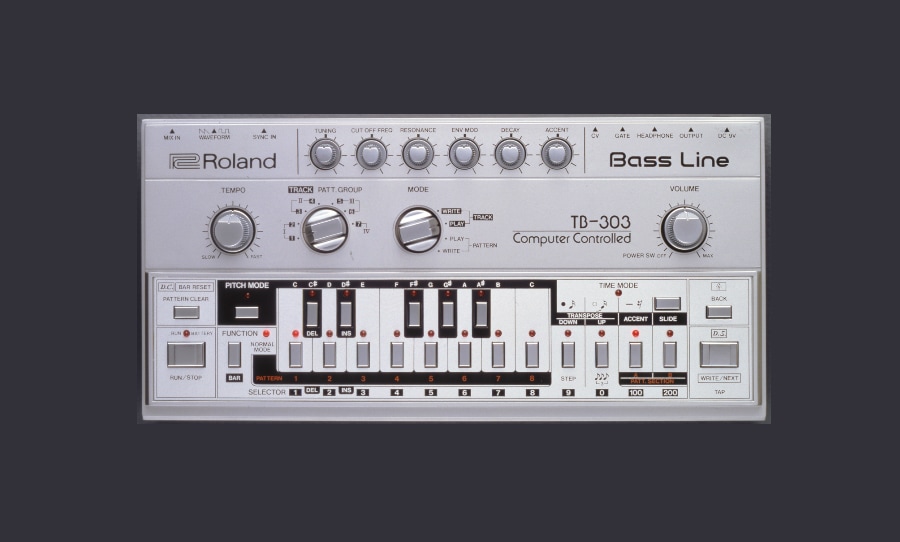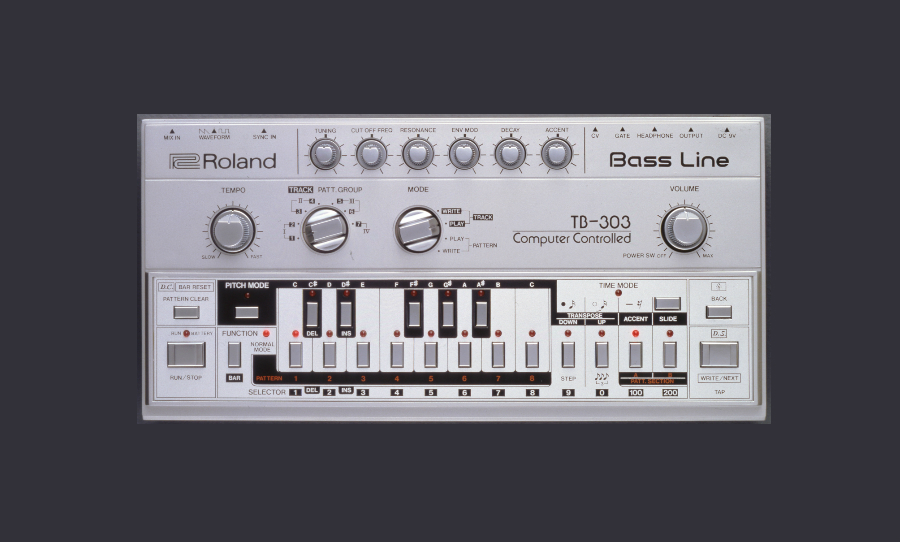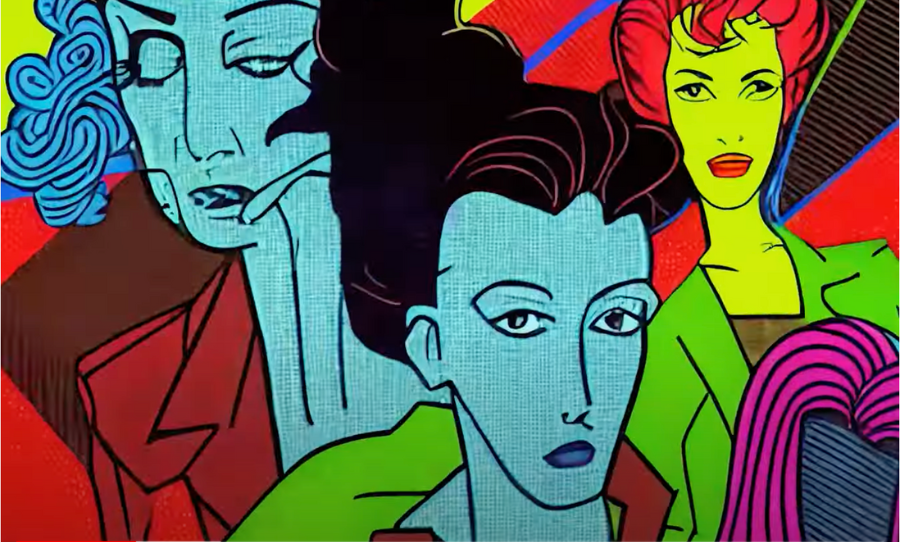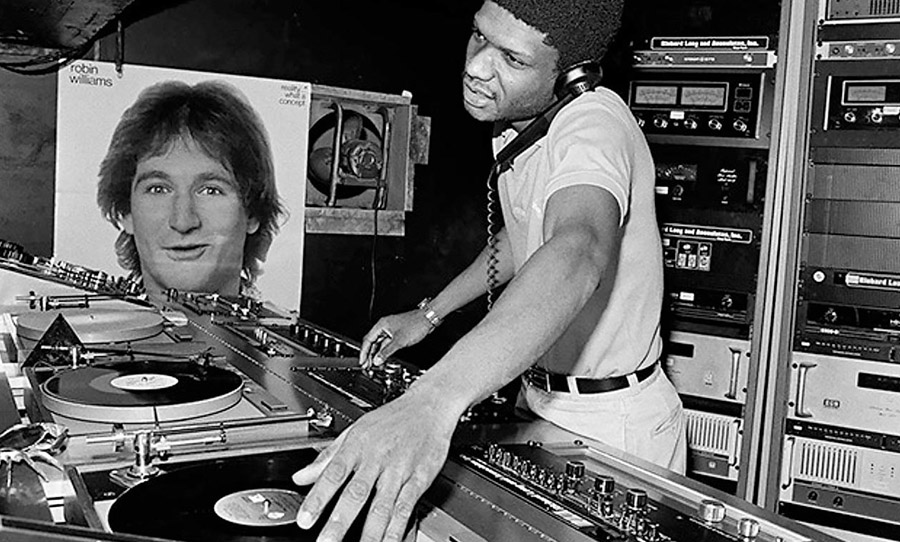You could call Roland’s TB-303 a happy little accident – a happiness that bore as many smiles on ravers sweating faces, as on the T-Shirts they wore (or the ecstasy tablets in their pockets).
Since its 1982 introduction, the TB-303 steadily grew a cult-like following and now holds an almost legendary status. Look for yourself on E-bay or Reverb, original units are going for well over $3000 – not bad for an item that was written off as a commercial flop after 2 years.
Originally a commercial flop, the Roland TB-303 Bassline soon grew a legendary, cult-like status amongst Dance Producers.
An Out of Place Bass
In the early 1980s, the Roland Corporation had enjoyed a fruitful decade in manufacturing electronic instruments and guitar effects. Along with increased access to Western electronics came Western music influences; Roland cleverly used this trend to create relevant and intuitive instruments.
Having already designed the TB-606 drum machine, Roland engineer Tadao Kikumoto intended the TB-303 to emulate a bass guitar and to replace it in situations where musicians were solo or could not afford a player. Coupled with the TB-606 the pair allowed a user to become a one-person band. The TB-303 dropped in 1982 for $395 US or £238 UK, not cheap for a small synth with a completely unfamiliar design.
The 303 had to be plugged into an amplifier and once a sequence of notes was set, the user had a variety of knobs which they could manipulate, including the filter knob (replacing a traditional tone knob), tuning knobs, resonance, envelope, modulation, octave, decay and accent. The single oscillator had the option of a sawtooth or square wave and was fed through a 24db low pass filter, controlled by the envelope. The keyboard spanned one octave, with each key holding a bank of memory for sequencer presets.
Early Basslines
The sequencer function of the 303 was a somewhat painstaking process, something that detracted from people giving the unit a second look. Even the manual, which came with several tutorials, stated that: “You may have difficulty as the TB-303 is different to a bass guitar or keyboard”.
The unit did not exactly take off and its use in popular music at the time was limited. The UK pop act Imagination, used the 303 in the 1982 song, In The Heat of the Night, where it plods along in an orderly fashion with the beat – not overly inspired. The problem? They were using the Bassline as it was intended…
Production of the TB-303 stopped in 1984 with about 20,000 units produced, with Roland writing it off as a commercial failure. So unloved was the little synth, that they began selling cheap in pawn shops.
Basslines For Breakdancing
The rise of breakdance culture introduced many new production techniques into the popular music sphere. Breakdance musicians were not afraid to experiment with different electronics such as samplers and the odd-ball 303.
An example is the 1984 single Jam On It by the New York hip-hop group Newcleus. The same bassline is looped repetitively, using a higher octave, a strange move that sounded a lot more unique than trying to replicate the sounds of a bass guitar. This sound would go on to influence other hip hop artists, as well as the America’s infant house scene.
Despite Newcleus’ novel bass sequencing, most of the 20,000 303s sat around gathering dust between their faux-keys. It seemed like the little synth was never meant to be, or perhaps it was just five years ahead of its time…
Acid House & The Second Summer of Love
As the 80s drew to a close the 303 finally found the love it deserved. The Chicago house group Phuture released Acid Tracks in 1987, which is often cited as one of the first examples of acid house.
The 303 was used extensively but in a completely new way – all 6 knobs were manipulated live as the sequencer rolled, erasing all resemblance to traditional bass sounds. The result was completely alien. A squelching liquid sound, like extra-terrestrials signalling from space. It was like nothing ever heard before and it didn’t take long for the trend to catch on and skip across the pond.
1989 saw one of the UK’s biggest heatwaves in years, so hot the flowers wilted at the annual Chelsea flower show. Thatcher had celebrated her 10th year as prime minister with individualism and free enterprise being her political hallmarks. The rich were getting richer and the poor were excluded from their cocktail party. Record labels at the time were very much part of this regime, pop songs were manufactured and churned out with short-term profits in mind. But a scent of change was in the air, Europe was seeing the dismantling of the Eastern Bloc and disenfranchised youths sought a culture they could identify with, which brought them together in unison.
With disenfranchised youths and a heatwave causing a stir, the climate was just right – all that was needed was a spark to light the inferno: acid house, courtesy of the 303’s liquid baselines.
Like most new youth movements the music a was coupled with a new look: baggy clothes with zany designs and lashings of fluro, as well as a new drug – ecstasy, which kept house fans on their feet all night. Young people were able to break free of their restraints and feel as if they were a part of something larger than themselves. The 120bpm tracks were perfect for dancing and punters would pack into fields and warehouses in the thousands to move in unison to acid house’s hypnotic pulse. Songs such as 808 State’s 1988 Flow Coma were the rave generation’s Purple Haze, the outdoor raves their Woodstock. The so-called ‘Second Summer of Love’ was born.
Onto The 90s
The rave scene wasn’t left behind in the 80s. If anything it was taken to the next level. The 90s saw one of the quickest progressions of musical experimentation in history, it seemed almost every 6 months a new genre or sub-genre hit the airwaves, or vibrated the tin roofs of packed warehouses. The TB-303, when used with other electronic instruments, still offered an affordable way to make cutting-edge bass sounds for dance music.
The squelchy basslines can be heard on KLF’s 1990 house anthem, What time is love, which became a number 5 hit in the UK charts. Despite its continued popularity in the house scene, the 303 found its way into other emerging genres such as trip hop – check out Massive Attack’s, Protection – and IDM – check out The Black Dog’s, Chase the Manhattan.
The popularity of the 303 began to rise as the 90s progressed and so did the value of the unit. The cost of a good example was soon out of reach to the bedroom studio users who helped to popularise it in the first place.
Roland had noticed this steady cult following. Perhaps their strange little synth, now over a decade old, wasn’t the failure they once thought. In 1996 they created the updated remake, the MC-303 Groovebox, which was an instant hit, selling 50,000 units. Purists preferred the retro analogue 303, however, it was loved by those who missed out on an original.
In the same year Roland’s little synth was lyrically immortalised on Fatboy Slim’s first single of his first album, Everybody Needs a 303. By the late 90s, it made a number 1 hit in the US and UK – via the Prodigy’s Smack my bitch up. Even Madonna, the Queen of Pop, couldn’t resist, including a 303 16th note pattern on her 1998 hit Ray of light.
Modern Use: Software and Reissues
With 303 prices becoming unreachable to aspiring musicians, software such as Rebirth’s Propeller Head, gave greater access to a new generation who relied on laptops more than hardware. With representations of the 303 displayed on a 2D screen, emulating a decades old hardware unit, which in itself was created to imitate a bass guitar – there exists a little irony. Such is the accidental success of Roland’s little odball synth.
Clones have been produced in one way or another by most of the leading music brands, from Novation to Native Instruments, each trying to replicate the magic sound of the circuit that started it all.
Roland’s 2014 Aira series introduced a digital reinterpretation of the 303, known as the TB-3 and recently unveiled a modernised reissue of the TB-03 on ‘909 day’ last year as part of their boutique line-up. A cheap mobile version even exists, the Digital Bass Line, created by Pulse Code Inc. for $2.99.
To this day dance producers still can’t get enough of the squelching 303 sound, perhaps Fatboy Slim was right. Everybody needs a 303.




